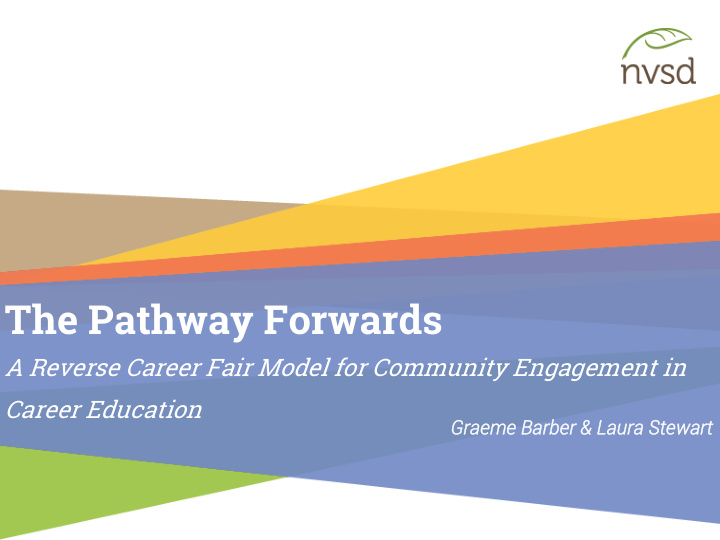



The Pathway Forwards A Reverse Career Fair Model for Community Engagement in Career Education Gra Graeme eme Barb rber er & Laura ra Stew ewart rt
Acknowledgements
Who Are We? Laura Stewart Graeme Barber • French Immersion • Math/ Careers Teacher Teacher/ Teacher • Passionate about Leader technology & • Passionate about meaningful engaging students assessment in meaningful learning @MrGBarber @mmelstewart
Session Goals • Experience a version of a reverse career fair • Understand curriculum connections to Career Life Education • Learn details of year plan and project execution • Reflect on challenges and ways to implement experiential learning in Careers curriculum
Experience a Reverse Career Fair
Reverse Career Fair Fill out the sheets on your table § Who are you? § What is your interest in career education? § What is your challenge or key question right now with respect to career education?
Community Networking Mix and mingle! • If your paper has a star, invite colleagues into a conversation • If your paper has square, look for someone new to talk to • Introduce yourself and share your challenges
Table Discussions • How did you feel going into these mini presentations? • What benefit did this process have for you?
Curriculum Connections
Our Questions • How do we make our careers curriculum real for all students? • How do we engage our community partners in career education? • How do we teach meaningful life skills?
Year at a Glance My My Planning Hire Me! Action Plan
Project Goals • Engage students in real-life situations • Engage the community in career education • Open students’ horizons to “real world” jobs • Engage students in authentic communication
Curriculum Connections
Career Life Education Cultivating networks Career life choices are and reciprocal made in a continuing Big Ideas relationships can cycle of planning, support and broaden reflecting, adapting career-life awareness and deciding and options Ways to represent Personal networking Content themselves both and employment personally and marketing strategies publicly Collaborate with Explore and connect supportive experiential learning Competencies community members inside and outside of to explore the school with possible reciprocal influences and preferred career- of career-life choices life pathways
Indigenous Education Learning is holistic, reflexive, reflective, experiential, and relational
Our Reverse Career Fair Model
Term 1: My Planning Self-Discovery • Who am I? • ABC Career Project
Term 2: Hire Me Employment Skills • Job finding • Networking • Resumé building • Cover letter • Interview skills
Term 3: My Action Plan Reverse Career Fair Prep • Identify local businesses • Cold call for invitations • Re-visit post-secondary plan
Path Forward Final Assessment • Develop a visual presentation • Depth: Choose one career path and research thoroughly with options • Breadth: Choose multiple paths and give details of each
Criteria Pr Progr ograms/ / traini ning ng Bu Budget Post Secondary Ac Accommodation Grade 11/ 12 Courses Tr Travel Interests Values Tr Transpor nsportation on Passions Possibl Pos ble e hur hurdl dles es
Organization • Weeknight in June, 5-7pm • Students each had a table or wall space in school hallways, common areas • 4 classes - 100 students • All parents invited • Approximately 100 parents & community members
Summative Assessment • Professional tenure • Networking skills • Visual presentation • Path forward: research & content • Reflection
Variations • En français! • Job fair early in the year • Use of technology
Questions?
Reflections on the Year
What Worked? • Student engagement • Authentic communication & networking • Community partnerships • Student employment connections • Parent engagement • Authentic assessment
Challenges • Layout and flow • Some students didn’t have enough people to talk to • Business partners • Technology
Table Discussion • What new ideas do you have? • Does this inspire any ideas for your context? • How can we make learning more hands-on?
Get in Touch Graeme Barber gbarber@sd44.ca Laura Stewart lstewart@sd44.ca Electronic files available at: https://goo.gl/XgUfwi
Recommend
More recommend